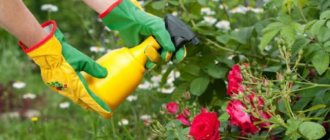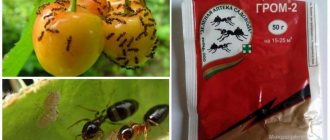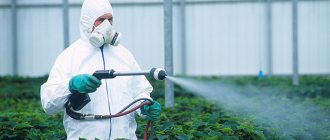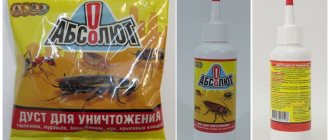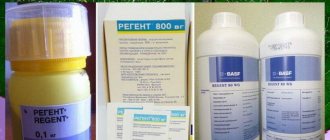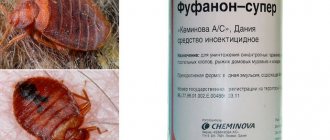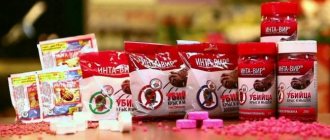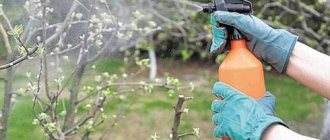Varieties of Kleschevit
There are several types of this insecticide, differing in release forms and properties.
. Varieties of this drug can be used in different conditions, and this must be taken into account when carrying out treatments, otherwise the quality of the fruit may deteriorate sharply.
Kleschevit Super Spray
This spray is intended for treating clothing against ixodid ticks; this drug also effectively kills fleas. This product is specially produced in the form of a spray to make it easier to use. Release form: 100 ml bottle. After treatment, Kleschevit Super Spray protects clothes for 2 weeks. The active substance of this drug is alphacypermethrin.
Kleschevit Super
This variety of Kleschevit is a concentrated emulsion, available in 100 ml bottles. The active substance included in Kleschevita Super is cypermethrin (up to 25% of the total volume of the product).
The product Kleschevit Super is used for spraying the area around buildings and gardens, and is used for protection against ixodid ticks. The insecticide begins to destroy insects within 30 minutes after treatment.
When preparing the working fluid, you should follow the instructions for use of the product. This insecticide protects the treated area for 30 days. Usually the solution is prepared as follows: 5 ml of the product is dissolved in 2 liters of water.
The drug Kleschevit
This insecticide is used more often than other varieties, as it has a wide spectrum of action.
This product is used for treating garden and vegetable crops, as it has low toxicity.
Composition and principle of operation of the drug Kleschevit
Under one brand name “Kleschevit”, three different drugs are presented on the market, differing in purpose, active ingredients, and methods of application.
- Kleschevit Super Spray is a product created for household use that protects people from fleas and ixodid ticks. A solution of the active alphacypermethrin is sprayed onto clothing as a protective agent. Available for sale in 100 ml aerosol bottles.
- Kleschevit Super is a product designed to disinfect summer cottages from ixodid ticks. The active ingredient is highly concentrated cypermethrin. Emulsion concentrate is supplied in 100 ml bottles.
- Kleschevit is a biological insectoacaricide, the composition is based on the drug aversectin C, produced by the bacteria Streptomyces avermitilis. Designed to protect fruit and berry trees and shrubs, vegetable crops, garden ornamental and indoor plants from piercing, sucking and gnawing insect pests. Available in the form of an emulsion concentrate of 4 and 10 ml.
Both acaricides, Kleschevit Bio and Kleschevit Super, are nerve-paralytic poisons of contact-intestinal action. The impact begins after the substance enters the arthropod’s body. The poison, inhibiting the nervous system of the tick, causes paralysis.
Tick medicine - Kleschevit
Aversectin C begins to act within a few hours, complete destruction of pests occurs in 3-6 days. Aversectin C does not accumulate in plants or in the external environment. The product is not detected in fruits and leaves after three days; in the soil it disintegrates after 30 hours.
The action of cypermethrin is also quite fast, however, the half-life in the soil, depending on its type, occurs up to 12 months. At normal humidity, under the influence of sunlight on the grass, the substance decomposes within 2-3 weeks. Therefore, it is not recommended to treat plantings of cultivated plants with Kleschevit Super.
What pests is it used against?
Kleshevit Super and Kleshevit Spray have a narrow focus, and only Kleshevit is able to cope with the following pests:
- spider and other types of mites;
- Colorado potato beetle;
- cabbage moth;
- whiteweed;
- flower thrips;
- whiteweed;
- leaf roller;
- aphids;
- weevil;
- codling moth.
special instructions
While working with Kleschevit preparations, it is forbidden to eat, drink or smoke. Immediately after spraying crops, wash your hands with soap and wash. When an insecticidal agent gets on the skin, an allergic reaction occurs, and intoxication of varying degrees of severity occurs in the respiratory tract.
It is forbidden to work with toxic substances for pregnant women, lactating women, people prone to allergies, respiratory diseases, or breathing difficulties.
If, during the process of spraying plants against ticks, dizziness, nausea, weakness, or headache occur, work should be stopped. Rinse your mouth with a soda solution, take activated carbon at the rate of 1 tablet per kilogram of weight. If the condition does not return to normal, you need to seek help from specialists.
On a note!
Kleschevit super is used to treat areas against ixodid ticks. Destroys adults, nymphs, larvae of different ages. Protection after one spraying lasts 20 days. Disinsection is carried out wearing gloves, a respirator, and a protective suit.
Kleschevit: instructions for use against pests
This insecticide should be used depending on the variety of cultivated plants, as well as the degree of their damage by insect pests.
The Kleschevit working solution is prepared in accordance with the types of garden or vegetable crops that will be treated with it.
Potato mites
This vegetable crop is treated with Kleschevit against the most important pest - the Colorado potato beetle. The working liquid for spraying is prepared as follows:
10 ml of the product is dissolved in a bucket of water. Tops are processed during the period of active growth of green mass.
Insect repellent Kleschevit - video
The number of treatments of a potato plantation against the Colorado potato beetle with Kleschevit is no more than 3 with an interval of 3 weeks between them. Usually, at least two sprayings are carried out to completely kill the Colorado potato beetle.
The consumption rate of working fluid is 5 liters of fluid per hundred square meters.
Insecticides:
Coragen Shar Pei Insegar
Mites for treating cabbage against pests
Cabbage should be treated with a solution of the insecticide Kleschevit against:
- cabbage whites;
- white turnip;
- cabbage scoop.
To process cabbage, prepare the following working liquid: dilute 40 ml of the drug in a bucket of water.
Spraying is carried out twice with an interval of 2 weeks. Consumption of the drug per hundred square meters is 4 liters.
Mites for currants
Various pests can settle on currants, and the dosage of the drug when preparing the working solution will also be different.
To deal with mites that have appeared on this berry bush, the following working liquid is prepared:
20 ml of Kleschevit is diluted in 10 liters of water.
Treatments must be carried out during active growth of the vegetative mass. For each bush, 1 liter of working solution should be used. Treatments of currants with mite mites are carried out until the mites are completely destroyed, and the interval between sprayings should be at least a week. But usually carrying out this procedure twice is enough. Against moths and leaf rollers, currants are treated with Kleschevit twice with a break of a couple of weeks. The working solution is prepared as follows:
15 ml of the drug is dissolved in 10 liters of water.
Application of Kleschevita against apple tree pests
These fruit trees are often damaged by various pests; working solutions of Kleschevit can be prepared with different dosages of the product.
Against spider and red fruit mites, Schlechtendahl mites, leaf rollers and moths, up to 3 treatments should be carried out with an interval between them of up to 12-14 days. Against spider mites, several treatments of the apple tree with Kleschevit should be carried out with an interval of 6-8 days, and against leaf rollers, the interval between sprayings should be 14-28 days. The working solution is prepared as follows:
take 15 ml of insecticide per 10 liters of liquid.
The consumption of working fluid depends on the size of the tree crown and the size of the pest colony - from 2 to 5 liters for each apple tree. The solution against codling moths and moths is prepared as follows:
take 20 ml of the drug per 10 liters of water. In this case, 2-5 liters of working fluid are consumed for each apple tree.
For cucumbers, bell peppers and eggplants
Against mites, Kleschevit solution is also used to treat these vegetable crops. Moreover, peppers and cucumbers are treated with the product during the flowering period, and eggplants - during the period of active growth of green mass. The working fluid is prepared as follows:
dissolve 10 ml of the product in a bucket of water.
Usually at least 2 treatments are carried out, the interval between them should be long - at least 3 weeks. For every hundred square meters of area, use a bucket of working solution. Against melon and peach aphids, cucumbers, peppers, and eggplants are treated with a more concentrated solution - 40-60 ml of the product is dissolved in a bucket of water.
Use this working solution as follows:
- spraying is carried out up to 3 times;
- between treatments you need to take a break of 2 weeks;
- For every hundred square meters of area, a bucket of working fluid is consumed.
Against tobacco and Californian thrips, cucumbers, bell peppers and eggplants are treated with a strong concentration of Kleschevit solution. To do this, dissolve 100 ml of the product in a bucket of water. If these vegetable crops are severely affected, then treatments must be carried out three times with an interval of 2 weeks between them. If there are not too many pests, then only a couple of sprayings can be done.
Treatment of currants with Kleschevit
Kleschevit, according to the instructions, is used to destroy herbivorous mites on currants. Treatment is carried out twice: the first time when arthropods appear, the next time after 20 days as necessary.
For the working composition, 2 ml of the drug is dissolved in 1 liter of water. This volume is enough to spray 1 bush.
Treatment of fruit and vegetable crops with Kleschevit
The acaricide Kleschevit, as indicated in the instructions for use, is used to protect cucumbers, eggplants, tomatoes, and peppers in protected soil from spider mites. The maximum possible number of treatments is 2 times: when pests appear, then after 3 weeks for complete destruction.
Professional help from gardeners and gardeners Still have questions? Ask, don't hesitateAsk a question
The concentration of the solution in this case is: 10 ml of insecticide per 1 liter of water. This volume is enough to spray one hundred square meters of land.
Treatment of ornamental plants with Kleschevit
Treatment of flower plants with a preparation against spider mites is possible both in open ground and in protected ground. Only the frequency of application differs. For greenhouse ornamental crops, the maximum number of sprayings should not exceed 3 times at intervals of 7-10 days; for flowers in flower beds, the procedure can be carried out 4 times at intervals of 3 weeks.
In both cases, the concentration of the solution is the same: 2 ml of acaricide per 1 liter of water. To treat 1 hectare of land, 10 liters of working fluid will be required.
Treatment of indoor plants with Kleschevit
The insectoacaricide Kleschevit, in accordance with the instructions for use, is also used for spraying indoor plants against spider mites. Potted flowers can be processed up to 4 times at intervals of 7-10 days.
Spray no more than 200 ml of the prepared solution per 1 m², for which 2 ml of the drug is dissolved in 1 liter of water.
Advantages and disadvantages
The main advantages of the Kleschevit insecticide include:
- wide spectrum of action;
- possibility of use for processing garden and vegetable crops in open and closed ground, as well as for indoor plants;
- Insect pests do not develop resistance to the drug, so Kleschevit can be used continuously during the summer season every year;
- ease of dilution of the drug and ease of spraying;
- The product effectively destroys all pests and begins to act on them within a few hours after treatment. And the complete death of insects occurs a few days after poisoning.
This insecticide has no particular disadvantages. You just need to follow the dosage of the drug when preparing the working fluid, and also carry out treatments at certain intervals.
Photo of instructions for use of the drug Kleschevit from the manufacturer
Reviews
Inga: unfortunately, the drug does not affect eggs and larvae of younger pests. And the drug will also not reach adult mites hidden in the leaf axils. This is the main drawback of Kleschevit.
Andrey: Kleschevit’s effect is approximately the same as that of Fitoverm, but it seemed to me that it was a little weaker. But Kleschevit is not very toxic and quickly disintegrates without poisoning the soil, air, water and plants.
Gardener: The drug Kleschevit is inexpensive and dissolves easily. I treated the rose for spider mites, but at first I didn’t notice any changes. I took a magnifying glass and carefully examined the bush: I didn’t find any ticks. Then the leaves gradually fell away.
Official website and manufacturer's recommendations: https://dacha.avgust.com/catalog/kleshchevit/
- How best to treat plants with Fitosporin-M
Hazard class and precautions
The tick insecticide is classified as hazard class 3,
therefore, the drug is low-hazard for humans and warm-blooded animals. Although it is believed that this product is low-hazard for bees and can be used even during the flowering period of cultivated plants, in apiaries it is still necessary to limit the number of bees in the period of treatment of plants and release them the next day after spraying.
Important!
The insecticide Kleschevit is dangerous for the inhabitants of water bodies, so it is not advisable to spray near rivers, lakes or ponds.
KLESCHEVIT and Green soap. Fighting ticks - video
When working with the drug, the following safety precautions should be taken:
- the human body must be completely hidden under clothing;
- the respiratory tract is protected with a respirator, and hands with rubber gloves;
- It is required to wear closed shoes and a hat;
- the drug is not sprayed in windy and rainy weather;
- after finishing work, rinse your mouth and rinse your eyes under running water;
- Do not eat, drink or smoke while spraying;
- After finishing work, you need to take a shower and wash your clothes separately from other things.
Restrictions and security
a) Hazard class for warm-blooded organisms – class 3 (low-hazard). When working with a pesticide, you should follow generally known personal safety standards and use PPE. When working with the drug, you should be guided by the standards OST 6-15-90.4-90 and SanPiN 1.2.2584-10. The deadline for manual work is 1 day.
b) Hazard class for bees – class 3 (low danger). The developer sets a border protection zone for bees of 4-5 km, for aerial processing - 5-6 km, and the flight limit for bees should be 1-2 days. It is recommended to carry out ground treatment of plants in the morning or evening hours at a wind speed of 2-3 m/s, for aerial treatments 0-1 m/s.
c) The use of the insectoacaricide “Kleschevit, KE” in the water protection zone is prohibited.
d) Toxicological characteristics. The waiting period before harvesting is 3 days (the active substance is not fixed in the leaves after 2-3 days, and in the fruits after 3 days). When applied to the soil, the substance does not enter the roots of plants.
Compatibility of Kleschevit with other drugs
The drug Kleschevit is compatible with the following chemicals:
- Fufanon;
- Actellicom;
- Talstar.
When using these drugs together, it is recommended to reduce the dose of the drugs by 2 times.
Kleschevit can be used alternately with various biological preparations - the interval between treatments with different agents should be at least a week.
Important!
It is forbidden to use Kleschevit simultaneously with Vermitec.
Fungicides:
Fungicide Discor Fungicide Profit Gold Preparation Mancozeb
Mechanism of action
Tick tick repellent based on aversectin C is a biological preparation. It begins to act immediately, but the effect is noticeable after 5-7 days. The active substance has insecticidal properties and disrupts the functioning of the nervous system of insects. It enters the body of ticks during feeding. The rate of death depends on the accumulated amount of toxic substance. The spider mite dies within a week.
The drug Kleschevit against ticks
Kleschevit super is a toxic drug based on cypermethrin (25%). Destroys parasites in 2 hours, remains active indoors for 20 days, outdoors for 20 days. It enters the body of ticks upon contact through the chitinous cover, during feeding. Provokes muscle paralysis in 5 minutes. Mass death of pests occurs within 30 minutes.
The drug Kleschevit: reviews of use against pests
Elena, 35 years old, Stavropol: I treat apple trees with Kleschevit, and all the pests die after just a couple of treatments. But even when spraying in protective clothing, I have an allergic reaction to this product. But this is explained by the fact that I am an allergy sufferer in life.
Lera, 40 years old, Rostov-on-Don: This product is very helpful in treating vegetable crops against major pests. But its price is quite high, and when cultivating my large garden I have to spend a lot of money.
Valentin, 47 years old, Perm region: Kleschevit is a fairly effective drug against most garden and garden pests. You just have to follow a number of rules - follow the dosage of the product, maintain the intervals between spraying. But overall I am pleased with this insecticide.
This drug can be used to combat many insect pests that attack garden or vegetable crops, indoor flowers and plants.
The insecticide begins to “work” within 6 hours after spraying, while 2-3 treatments are sufficient to completely kill the pests. Thanks to the undeniable advantages of the drug, its popularity among gardeners, flower growers and vegetable growers is constantly growing.
Kleschevit reviews
In general, mite tick acts in the same way as phytoverm; many gardeners will call it a weak remedy, but for some it helps a lot. Why such conflicting reviews? The fact is that the drug only helps if the pest feeds on sprayed leaves or when there is contact with the integument of insects or arthropods (mites).
If there are pests on the plants in the stage of eggs or non-feeding larvae, there will be no effect. In addition, adult pests (adult stage), which hide in secluded places during spraying - leaf axils, inside a deformed leaf blade, will also not be harmed - the solution will not touch them. If you don't wet the leaves well, they won't even get enough of the poisonous part of the leaf. The problem with mite mite is that the drug does not have a systemic effect - it does not penetrate deeper into the leaf. Those. if the sheet was wetted only from the top, but the solution did not get on the back side, this part of the sheet remains defenseless.
You can expect good results from mite mite if you have thoroughly sprayed the entire plant; small indoor flowers can be completely dipped in the solution. We can say that the drug is completely useless for spraying plants (varieties) with curly leaves, for example, ficus baroca, or if the leaves are severely deformed, for example, the shriveled tops of raspberry branches should be treated by dipping in a bucket of solution, rather than trying to spray.
Plus, the undoubted advantage of the drug Kleschevit is its low toxicity - it is destroyed on the leaves 2-3 days after treatment, and in the fruits of vegetables after 2 days. This means that it can be used to spray homemade fruit lemons, vegetables and berries in the garden 3 days before harvest.
Do not use the drug Kleschevit more than three times; resistance increases (each time the percentage of survivors increases).
It was found that the effectiveness of the insecticide against spider mites is greatly influenced by air temperature, so the drug is most toxic at a temperature of 30-32°C, more or less effective in the range from 24 to 26°C, and not effective at temperatures below 20°C. This is explained simply - the tick development cycle accelerates at high temperatures, and most of the feeding individuals manage to fall under the action of the drug.
Consumption rates
Spraying plants with a solution of weak concentration will not give a positive result. Using higher doses may cause burns on the leaves. Adding an insufficient amount of the drug also leads to a lack of results. Therefore, Kleschevit must be used strictly according to the instructions, adhering to the dosages and method of application recommended by the manufacturer.
- The consumption rate of the drug when spraying cucumbers, tomatoes, peppers and eggplants is 1 liter of working fluid per 100 m².
- Consumption for 1 currant bush - 1 liter.
- One tree requires from 2 to 5 liters of working product, depending on the age and size of the fruit crop.
- To treat flowers growing in open ground, use 1 liter of solution per 10 m² of planting.
- The consumption rate of Kleschevit for indoor plants is 0.1 liters of working fluid per 1 m².
Advantage and scope
The main advantages of the insecticide include:
- Fast exposure period.
- Safety for warm-blooded animals (the drug has low toxicity).
- Highly effective in controlling various insect pests.
The scope of application of the product depends on its release form.
- Mite mites 0.2% - used to combat spider mites on fruit and berry crops growing in open ground. The product is also effective when treating fruit, vegetable and flower crops, and potted plants. This form can be used to process greenhouse plants and indoor flowers.
- Kleschevit Super - used to combat ixodid ticks in flower beds and lawns.
- Spray Kleschevit Super - the purpose of this preventive sanitary acaricide is to treat clothing before visiting places where ixodid ticks and fleas live.
Kleschevit Super
Instructions for use of the drug Kleschevit Super differ from its use. This product is suitable for treating lawns, low shrubs, and garden areas (alpine lawns, flower beds, flower beds).
Composition of Kleschevita Super
To destroy forest and taiga ticks, make a solution of 5 ml of the product and 1-2 liters of water. To destroy other types of arachnids, a liquid is made from 12 ml of product and 1-2 liters of water. Treatment begins after the snow melts and continues until autumn. The interval between spraying is 2 weeks. The effectiveness of the product is 7-45 days.
Storage conditions and shelf life
To store the insecticide, use a dry, cool place protected from direct sunlight. The product is stored away from food and animal feed. Its shelf life is 2 years from the date of manufacture.
Since the solution does not affect pests hiding in rolled leaves, it is recommended to remove and burn such leaves. The product is not able to affect tick eggs - they do not eat plant sap and, accordingly, cannot be poisoned. To achieve complete destruction of pests, including young mites emerging from eggs, it is necessary to carry out several treatments.

